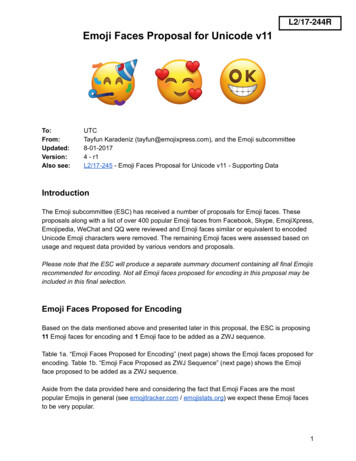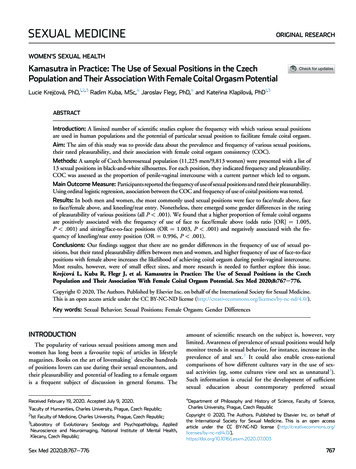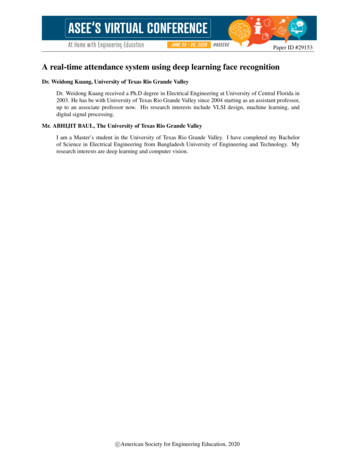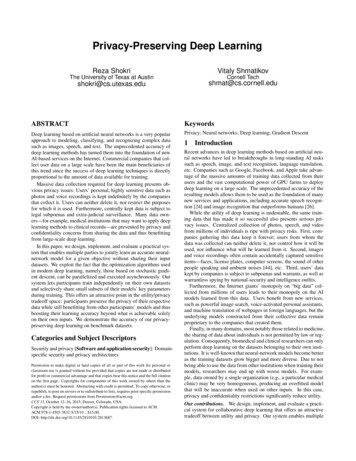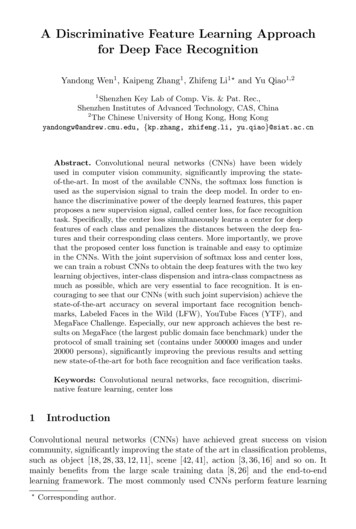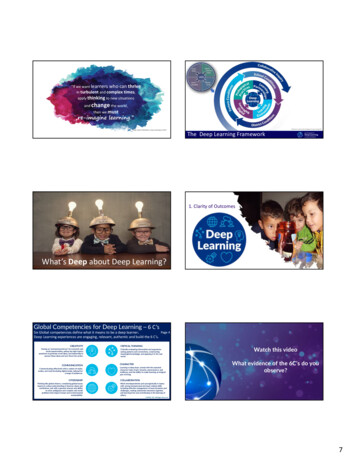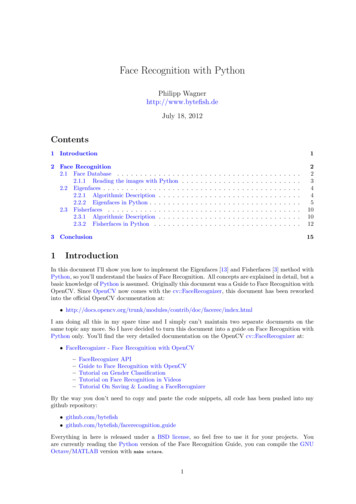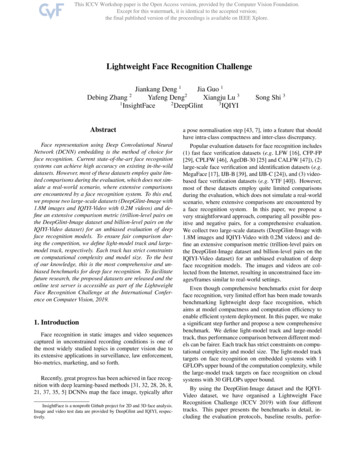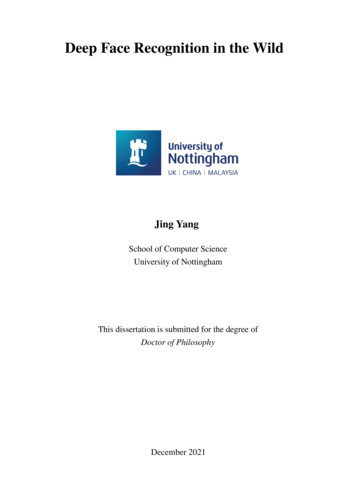
Transcription
Deep Face Recognition in the WildJing YangSchool of Computer ScienceUniversity of NottinghamThis dissertation is submitted for the degree ofDoctor of PhilosophyDecember 2021
AcknowledgementsFirst and foremost, I would like to express my deepest gratitude to my supervisor, Dr. GeorgiosTzimiropoulos for his continuous guidance, support and encouragement throughout my PhD.I am grateful to Georgios for discussing the research topic, developing ideas, analysing theexperiments, polishing the paper writing and keeping and bringing hope when I have lost mine. Isincerely thank him for his creativity, kindness, patience, and extensive knowledge.Besides, I would like to thank my supervision team: Tony Pridmore and Michel Valstar whohave assisted my studies in several circumstances. Tony is the leader of the Computer Vision Lab,and he has created an effective research environment for us. The weekly lab meetings provideresearchers here with opportunities to share papers, discuss and develop research ideas. Michelis an excellent mentor who has given me valuable advice on the annual review, PhD planning andthesis schedule. Here, I would like to thank lab colleagues from B86: Aaron, Keerthy, Siyang,Kike, and Dimitris for their company and encouragement during my PhD.Moreover, I would like to thank my coauthor: Adrian Bulat. I particularly thank him forspending time on numerous discussions on research ideas, digging into the experiments, sharingexperiences in research. I would also like to thank Brais Martinez, who has helped me analyseexperiment results and polished my work on knowledge distillation. My thanks also go to JieShen, who gave me important suggestions on the system design.It goes without saying to present my appreciation to the Vice President’s scholarship andsupport from the Computer Science Department. The Vice President’s scholarship is veryimportant to me during the pursuit of the PhD degree as it has directly solved my financialburden.Last, but certainly not least, I want to dedicate this thesis to my parents for their unconditionalsupport in my life. I would like to thank them for their love and guidance that are with me forever.I am also grateful to my other family members and friends who have supported me along the way.I also would like to thank friends during my PhD life: Jiankang Deng, Yujiang Wang, PingchuanMa and Jiuxi Meng for their encouragement, support and company to get through the stressfullockdown time.
AbstractFace recognition has attracted particular interest in biometric recognition with wide applicationsin security, entertainment, health, marketing.Recent years have witnessed rapid development of face recognition technique in both academic and industrial fields with the advent of (a) large amounts of available annotated trainingdatasets, (b) Convolutional Neural Network (CNN) based deep structures, (c) affordable, powerful computation resources and (d) advanced loss functions. Despite the significant improvementand success, there are still challenges remaining to be tackled.This thesis contributes towards in the wild face recognition from three perspectives includingnetwork design, model compression, and model explanation. Firstly, although the facial landmarks capture pose, expression and shape information, they are only used as the pre-processingstep in the current face recognition pipeline without considering their potential in improvingmodel’s representation. Thus, we propose the “FAN-Face” framework which gradually integratesfeatures from different layers of a facial landmark localization network into different layersof the recognition network. This operation has broken the align-cropped data pre-possessingroutine but achieved simple orthogonal improvement to deep face recognition. We attribute thissuccess to the coarse to fine shape-related information stored in the alignment network helpingto establish correspondence for face matching.Secondly, motivated by the success of knowledge distillation in model compression in theobject classification task, we have examined current knowledge distillation methods on traininglightweight face recognition models. By taking into account the classification problem at hand,we advocate a direct feature matching approach by letting the pre-trained classifier in teachervalidate the feature representation from the student network. In addition, as the teacher networktrained on labeled dataset alone is capable of capturing rich relational information among labelsboth in class space and feature space, we make first attempts to use unlabeled data to furtherenhance the model’s performance under the knowledge distillation framework.Finally, to increase the interpretability of the “black box” deep face recognition model, wehave developed a new structure with dynamic convolution which is able to provide clustering ofthe faces in terms of facial attributes. In particular, we propose to cluster the routing weightsof dynamic convolution experts to learn facial attributes in an unsupervised manner withoutforfeiting face recognition accuracy. Besides, we also introduce group convolution into dynamicconvolution to increase the expert granularity. We further confirm that the routing vector benefitsthe feature-based face reconstruction via the deep inversion technique.
Table of contentsList of figuresviiList of 829303123Introduction1.1 Motivation . . . . .1.2 Problem Definition1.3 Contributions . . .1.4 Outline . . . . . .1.5 List of Publications.Literature review2.1 Components of Face Recognition . . . . . . . .2.1.1 Face Detection . . . . . . . . . . . . .2.1.2 Face Alignment . . . . . . . . . . . . .2.1.3 Face Recognition . . . . . . . . . . . .2.2 Knowledge Distillation . . . . . . . . . . . . .2.2.1 Logits-based Knowledge Distillation .2.2.2 Feature-based Knowledge Distillation .2.2.3 Relation-based Knowledge Distillation2.2.4 Self-distillation . . . . . . . . . . . . .2.3 Explainable AI . . . . . . . . . . . . . . . . .2.3.1 Network Visualization . . . . . . . . .2.3.2 Pattern Detector . . . . . . . . . . . .2.3.3 Learning Interpretable Representations.FAN-Face: a Simple Orthogonal Improvement to Deep Face Recognition3.1 Introduction . . . . . . . . . . . . . . . . . . . . . . . . . . . . . . . .3.2 Method . . . . . . . . . . . . . . . . . . . . . . . . . . . . . . . . . .3.2.1 Overview . . . . . . . . . . . . . . . . . . . . . . . . . . . . .3.2.2 Heatmap Integration . . . . . . . . . . . . . . . . . . . . . . .3.2.3 Feature Integration . . . . . . . . . . . . . . . . . . . . . . . .3.2.4 Integration Layer . . . . . . . . . . . . . . . . . . . . . . . . .
vTable of contents3.33.43.53.63.745Relationship to Previous Work . . .Training and Implementation DetailsAblation Studies . . . . . . . . . . .Comparison with State-of-the-Art .3.6.1 IJB-B and IJB-C Datasets .3.6.2 MegaFace Dataset . . . . .3.6.3 CFP-FP Dataset . . . . . . .3.6.4 LFW and YTF Datasets . .Conclusion . . . . . . . . . . . . .Knowledge distillation via softmax regression representation learning4.1 Introduction . . . . . . . . . . . . . . . . . . . . . . . . . . . . . .4.2 Method . . . . . . . . . . . . . . . . . . . . . . . . . . . . . . . .4.2.1 Softmax Regression Representation Learning . . . . . . . .4.2.2 Extension to Unlabeled Data . . . . . . . . . . . . . . . . .4.3 Relationship to Previous Work . . . . . . . . . . . . . . . . . . . .4.4 Experiments on Labeled Datasets . . . . . . . . . . . . . . . . . . .4.4.1 Ablation Studies . . . . . . . . . . . . . . . . . . . . . . .4.4.2 Comparison with State-of-the-Art . . . . . . . . . . . . . .4.5 Experiments on Unlabeled Datasets . . . . . . . . . . . . . . . . .4.5.1 Image Classification on CIFAR100 Dataset . . . . . . . . .4.5.2 Image Classification on ImageNet-1K-Sub Dataset . . . . .4.5.3 Face Recognition on UmdFace Dataset . . . . . . . . . . .4.6 Conclusion . . . . . . . . . . . . . . . . . . . . . . . . . . . . . .Interpretable Face Recognition via Unsupervised Mixtures of Experts5.1 Introduction . . . . . . . . . . . . . . . . . . . . . . . . . . . . . .5.2 Method . . . . . . . . . . . . . . . . . . . . . . . . . . . . . . . .5.2.1 Dynamic Group Convolution . . . . . . . . . . . . . . . . .5.2.2 Unsupervised Mixture of Experts . . . . . . . . . . . . . .5.2.3 Learning . . . . . . . . . . . . . . . . . . . . . . . . . . .5.3 Relationship to Previous Work . . . . . . . . . . . . . . . . . . . .5.4 Experiments . . . . . . . . . . . . . . . . . . . . . . . . . . . . . .5.4.1 Datasets and Pre-processing . . . . . . . . . . . . . . . . .5.4.2 Evaluation Metrics . . . . . . . . . . . . . . . . . . . . . .5.4.3 Implementation . . . . . . . . . . . . . . . . . . . . . . . .5.4.4 Variants and Analysis . . . . . . . . . . . . . . . . . . . . .5.4.5 Face Inversion . . . . . . . . . . . . . . . . . . . . . . . .5.5 Conclusion . . . . . . . . . . . . . . . . . . . . . . . . . . . . . 969727273747476767778788283
Table of contentsvi6858587Conclusions6.1 Summary of Thesis Achievements . . . . . . . . . . . . . . . . . . . . . . . .6.2 Future Directions . . . . . . . . . . . . . . . . . . . . . . . . . . . . . . . . .References89
List of figures2.12.22.32.42.52.62.72.8Overview of face recognition. It consists of face localization and face featureembedding. The white dots are detected 5 landmarks. The red dots forms themean face which is composed of left eye center, right eye center, nose tip, leftcorner of the mouth, and right corner of the mouth. The white landmarks arealigned to red landmarks to crop the normalized face area. . . . . . . . . . . .Contrastive loss. The goal is to pull features from same identity together andpush features from different identities apart. Different shapes denote differentidentities. . . . . . . . . . . . . . . . . . . . . . . . . . . . . . . . . . . . . .Triplet loss. The goal is to minimize anchor’s distance to its positive sample andmaximize the distance to its negative sample. Different shapes denote differentidentities. . . . . . . . . . . . . . . . . . . . . . . . . . . . . . . . . . . . . .Margin-based softmax Loss. It is a variant of softmax loss by adding the marginon the cosine distance between current sample and its prototype assigned bylabel. Different shapes denote different identities. . . . . . . . . . . . . . . . .The generic logits-based knowledge distillation. T, S, C denote teacher, studentand classifier respectively. LKD loss is added at the end of classifier’s output. . .The generic feature-based knowledge distillation. T, S, C denote teacher, studentand classifier respectively. LKD loss is added at different locations inside thebackbone. . . . . . . . . . . . . . . . . . . . . . . . . . . . . . . . . . . . . .The generic relation-based knowledge distillation. T, S, C denote teacher, studentand classifier respectively. LKD loss is added on the feature embedding extractedafter backbone. . . . . . . . . . . . . . . . . . . . . . . . . . . . . . . . . . .The generic self-knowledge distillation. S denotes student network. LKD loss isadded between intermediate network output and final classifier’s output. . . . .713131416171820
List of figures3.13.23.33.43.53.63.73.83.9Feature embeddings produced by our method (bottom) and our strong baselineArcFace [34] (top). Different colours represent different identities in t-SNEspace. The faces are from the CFP-FP dataset which contains frontal and profilefaces. ArcFace embeddings for faces A and B are much closer to D which is froma different identity but similar pose. Overall, for all 4 identities shown the featureembeddings produced by our method are much more concentrated and separatedthan those of [34]. See also section 3.6.3 for a quantitative comparison betweenthe two methods on the whole dataset where we show large improvement over [34].Overview of our method: We use a pre-trained Face Alignment Network (FAN)to extract features and landmark heatmaps from the input image. The heatmapsare firstly stacked along with the image and then passed as input to a FaceRecognition Network (FRN). The features (here taken from the high-to-low partof the 2-nd hourglass of FAN) are gradually integrated with features computedby FRN. Figure 3.4 shows an example of possible connectivity between the twonetworks. As the features from the two networks are not directly compatible, wealso propose a novel feature integration layer shown in Figure 3.6. . . . . . . .Heatmap integration. We concat the face image with the heatmaps predicted byFAN as final input to the FRN. . . . . . . . . . . . . . . . . . . . . . . . . . .Proposed 1:1 connectivity between FAN and FRN: at each spatial resolution,a feature tensor from the high-to-low part of the hourglass (shown in top) iscombined with a feature tensor from FRN (a ResNet34 in this example shown inthe bottom). The features are combined with the integration layer of Figure 3.6and used as input to the next layer of FRN. . . . . . . . . . . . . . . . . . . . .Proposed 1:many connectivity between FAN and FRN: at each spatial resolution,a feature tensor from the high-to-low part of the hourglass (shown in top) iscombined with a group of feature tensors with similar size from FRN (a ResNet34in this example shown in bottom). The features are combined with the integrationlayer of Figure 3.6 and used as input to the next layer of FRN. . . . . . . . . .The proposed integration layer. FAN features are processed by a batch normalization layer that adjusts their scale followed by a 1 1 conv. layer that furtheraligns them with FRN features. Then, An Adaptive Instance Norm makes thedistribution of the two features similar. The two features are combined via concatenation. Next, there is a 1 1 conv. layer followed by a batch normalizationlayer so that the combined feature can be added with the input FRN feature. Thevery last layer is a non-linearity in the form of PReLU. . . . . . . . . . . . . .Illustration of Residual unit in ArcFace [34]: BN-Conv-BN-PReLu-Conv-BN. .Visualization of feature maps from ArcFace (shown in top) and our model (shownin bottom). By using FAN features to guide FRN learning, facial landmarkrelated attention is added to the learned features. . . . . . . . . . . . . . . . . .ROC curves of 1:1 verification protocol on the IJB-B . . . . . . . . . . . . . .viii272930313232353741
List of figuresix3.10 ROC curves of 1:1 verification protocol on the IJB-C . . . . . . . . . . . . . .41Our method performs knowledge distillation by minimizing the discrepancybetween the penultimate feature representations hT and hS of the teacher andthe student, respectively. To this end, we propose to use two losses: (a) theFeature Matching loss LFM , and (b) the so-called Softmax Regression loss LSR .In contrary to LFM , our main contribution, LSR , is designed to take into accountthe classification task at hand. To this end, LSR imposes that for the same inputimage, the teacher’s and student’s feature produce the same output when passedthrough the teacher’s pre-trained and frozen classifier. Note that, for simplicity,the function for making the feature dimensionality of hT and hS the same is notshown. . . . . . . . . . . . . . . . . . . . . . . . . . . . . . . . . . . . . . . .Visualization of hS and hT on the test set of CIFAR100. Better viewed in color.Verification ROC and identification CMC curves of all distillation methods.Results are evaluated on refined MegaFace dataset. . . . . . . . . . . . . . . .Top-1 accuracy of KD, CRD, and Ours on CIFAR100 with 25%, 50%, 75%, and100% of Tiny-Train. The left hand result is from randomly selection and theright hand result is from confidence-based selection. . . . . . . . . . . . . . . .Teacher network is not robust on the unlabeled data after augmentation. Eachcolumn represents a couple of augmented inputs. For left column, teacher’spredictions are“table” and “beetle” respectively. For right column, teacher’spredictions are “train” and “bus”, respectively. . . . . . . . . . . . . . . . . .45554.14.24.34.44.55.15.25.35.42D feature space on routing vectors extracted from CNNs with dynamic convolution (DC:C 300 in Section 5.4 on Sub200 dataset in Section 5.4.1). Eachcolor denotes a couple of faces with shared attributes. For example, the redcolor represents young black women with left profile face. It shows that routingvectors convey attribute information. . . . . . . . . . . . . . . . . . . . . . . .Overview of the proposed framework. It combines a face recognition loss on thefinal feature representation with a clustering loss applied on intermediate routingweights extracted from several positions of the network. DGConv is short forDynamic group convolution. . . . . . . . . . . . . . . . . . . . . . . . . . . .Comparisons among three convolutions: (a) standard convolution, (b) dynamicconvolution with expert number n 3, (c) dynamic group convolution withgroups m 2 and expert number n 3. . . . . . . . . . . . . . . . . . . . . .Examples with annotated label ‘01111’, ‘10410’, ‘11122’, ‘00222’ respectivelyby each row. For example, ‘10410’ denotes faces with attributes: age in 20-49,female, white, small pitch angle, and yaw angle ‘ 30’. . . . . . . . . . . . . .61646470717276
List of figures5.55.65.75.85.9Histogram distribution on defined labels across FairFace, CelebA and IJB-C.The label number simply denotes the ith class of the given dataset. Notice thatnot all labels have faces associated with in the current dataset, as the 5-D vector,defining a class, may represent a combination of properties that doesn’t exist inthe current data. . . . . . . . . . . . . . . . . . . . . . . . . . . . . . . . . . .Feature visualization using t-SNE. The features are extracted by two baselinemethods (BL:C 300,DC:C 300) and three proposed variants (AS3:I,AS4,AS5)respectively. For BL:C 300, features are extracted after last 3 layers. For therest, features are the routing vectors. The images are from Sub200 dataset anddifferent colors denote different labels. . . . . . . . . . . . . . . . . . . . . . .Unsupervised discovery of facial attribute clustering from routing vectors. Thedashed rectangle is the mean face of each the clusters and the right ones areexamples belonging to each of them. The clusters are assigned by a trainedclassifier in AS5. . . . . . . . . . . . . . . . . . . . . . . . . . . . . . . . . .Cosine distance distribution among the k-means centroids calculated from modelDC:C 300 and AS3:I. . . . . . . . . . . . . . . . . . . . . . . . . . . . . . .Face inversion results. The first row is the input image. The second row showsinversion results from BL and the third row shows inversion results from CondFace. The left 6 columns are male faces across different ages, faces, and poseswhile the rest 6 columns are for female. . . . . . . . . . . . . . . . . . . . . .x7780818183
List of ication results (%) for different variants of our method on IJB-B dataset.All models were trained on a randomly selected subset of 1M images fromVGGFace2. The variants and other details are presented in Section 3.5. h2ldenotes the high-to-low part in hourglass structure while l2h represents thelow-to-high part in hourglass structure. . . . . . . . . . . . . . . . . . . . . . .Number of parameters and flops of different variants of our model. We comparewith both ResNet34 and ResNet50 structure. . . . . . . . . . . . . . . . . . . .Evaluation of different methods for 1:1 verification on IJB-B dataset. All methods were trained on VGGFace2 dataset. . . . . . . . . . . . . . . . . . . . . .Evaluation of different methods for 1:1 verification on IJB-C dataset. All methods were trained on VGGFace2 dataset. . . . . . . . . . . . . . . . . . . . . .Results (%) of our method and ArcFace (in-house) on MS1MV2 using ResNet100. Verification (Ver) is at FAR 10 4 . Identification (Id) is using gallery2. . . . . . . . . . . . . . . . . . . . . . . . . . . . . . . . . . . . . . . . . .Identification and verification results on MegaFace Challenge 1. Identificationrefers to rank-1 face identification accuracy and Verification refers to face verification TAR (True Acceptance Rate) at 10 6 FAR (False Acceptance Rate). Allmethods were trained on CASIA dataset. . . . . . . . . . . . . . . . . . . . . .Verification Results(%) on CFP-FP. All models were trained on CASIA. . . . .Verification performance (%) on LFW and YTF datasets. . . . . . . . . . . . .Structure of the Wide ResNet (WRN) networks used in our experiments. cdenotes number of classes. For CIFAR10, c 10. For CIFAR100, c 100.d (D 4)/6. . . . . . . . . . . . . . . . . . . . . . . . . . . . . . . . . . .Effect of proposed losses (LFM and LSR ) and position of distillation on the testset of CIFAR100. . . . . . . . . . . . . . . . . . . . . . . . . . . . . . . . . .KL divergence between teacher and student, and cross-entropy between studentand ground truth on the test set of CIFAR100. Teacher’s top-1 accuracy is 79.50%.Evaluation of different loss functions for LSR in terms of Top-1 accuracy onCIFAR100. . . . . . . . . . . . . . . . . . . . . . . . . . . . . . . . . . . . .L2 Distance hT hs 2 , and NMI calculated on the test set of CIFAR100. . .36383940404142435253545455
List of 4.184.19Transferability of representations from CIFAR100 to STL10 and CIFAR100 byfreezing f S and training a linear classifier on top. Top-1 (%) accuracy is provided.Top-1 accuracy (%) of various knowledge distillation methods on CIFAR10. . .Top-1 accuracy (%) of various knowledge distillation methods on CIFAR100. .Comparison with state-of-the-art on ImageNet. . . . . . . . . . . . . . . . . .Real-to-binary distillation results on CIFAR100: a real-valued teacher ResNet34is used to distill a binary student. Real-to-binary distillation results on ImageNet1K: a real-valued ResNet18 is used to distill a binary student. OFD result mightbe sub-optimal. . . . . . . . . . . . . . . . . . . . . . . . . . . . . . . . . . .MobileFaceNet architecture [23]. Each line describes a sequence of operations.Convolutions in the conv blocks use 3 3 kernels except the last conv blockusing 7 7. Each line denotes input feature’s spatial size (width height), outputfeature map’s spatial size, input feature map’s channel, output feature map’schannel, repeated number of this operation and stride size in convolutional layer.Groups represents the extension channel number and also the group number in3 3 convolution in bottleneck. . . . . . . . . . . . . . . . . . . . . . . . . .Face identification and verification evaluation of different methods on MegaFaceChallenge1 using FaceScrub as the probe set. “Ver" refers to the face verificationTAR (True Acceptance Rate) at 10 6 FAR (False Acceptance Rate) and “Id"refers to the rank-1 face identification accuracy with 1M distractors. . . . . . .Verification results on LFW, AgeDB, CPLFW, CALFW . . . . . . . . . . . . .Facial landmark detection with ResNet50 as teacher and ResNet10 as student.KD is adapted by using an L2 loss instead of a KL loss to measure the discrepancybetween the teach and student predictions. We use ResNet10 as student becauseResNet18 performance is close to ResNet50. . . . . . . . . . . . . . . . . . .Classification performance (%) of student models on CIFAR100. D meanstraining on CIFAR100-Train. D U means training on CIFAR100-Train and TinyTrain. CS denotes consistency loss and MP denotes training with 4.2.2. Averageover 5 independent runs. . . . . . . . . . . . . . . . . . . . . . . . . . . . . .Classification performance (%) of student models on CIFAR-100-test. Baselineis trained on D. D U MP is trained on whole dataset with individual knowledgedistillation loss and mix up in Section 4.2.2. Average over 5 independent runs. .Ablation studies on various design choices: labeled and unlabeled data rate,training epochs, data filtering, class balancing. “*” denotes that unlabeled datacome from rest of training set. . . . . . . . . . . . . . . . . . . . . . . . . . .Top-1 accuracy (%) of various knowledge distillation methods on ImageNet-529.ResNet50 as teacher and ResNet18 as student. . . . . . . . . . . . . . . . . . .ResNet101 as teacher and ResNet18 as student. Labeled data D is UMDFaceand unlabeled data U is VGGFace2. Verification results are on LFW, CFP-FP,AgeDB, CPLFW, CALFW. . . . . . . . . . . . . . . . . . . . . . . . . . . . .xii5557585859606061616265676768
List of tables5.15.25.3Purity and AMI on FairFace, CelebA, IJB-C and Sub200. BL and DC areclustered with k-means. AS1-AS5 are clustered with trained classifier. . . . . .Verification results on LFW, CFP-FP, AgeDB. 1:1 verification TAR (@FAR 1e4) on the IJB-B and IJB-C. . . . . . . . . . . . . . . . . . . . . . . . . . . . .Structural similarity, cosine similarity and verification accuracy on LFW ofbaseline model and CondFace. The cosine similarity and the verification accuracyare evaluated with ResNet101 trained on MS1MV3. Acc for BL, CondFace,ResNet101 on original LFW are 99.62%, 99.73%, 99.82% respectively. . . . .xiii798083
Chapter 1Introduction1.1MotivationWith the rapid development of technology, biometric recognition software plays an increasinglysignificant role in modern security. Biometrics is the measurement and analysis of a human’sdistinctive physical or behavioural characteristics. Examples include but are not limited tofingerprint, retinal scanning, voice identification and facial recognition. Among them, facerecognition has attracted particular interest because it’s very easy to deploy. Face recognitionaims at matching a given human face against a database of faces by measuring the distance offeature embeddings. Its applications have penetrated into various areas and here we categorizethem into four broad domains: entertainment, health, marketing and security.In security, recently released smartphones like Huawei, Xiaomi, Samsung, iPhone alllaunch a recognition-based authentication system to unlock phones. Compared with fingerprintauthentication, the competitive advantage of face recognition is quick response and non-contactmeasurement. Such a system is also widely installed in various public places like railway station,airports, office buildings in China. It also assists officers in identifying and tracking criminals bycomparing the suspect’s face with the faces from surveillance camera systems.In entertainment, face recognition is especially popular in social media. DeepFace froma research group in Facebook creates digital profiles from users and is used to identify humanfaces in digital images. Google photos employ the face recognition technique to sort picturesand automatically tag them based on the identification. FaceApp launched in IOS and Androidsystems provide the users to do some face editing works such as smile filter, hairstyle filter andage filter. These functions have added lots of fun to our daily life.In health, face recognition has been used to diagnose diseases especially for those causingappearance changes. For instance, the National Human Genome Institute Research Instituteemploys face recognition to detect DiGeorge syndrome. Apple has launched two open-sourceframeworks ResearchKit and CareKit to assist clinical to monitor patients health remotely.Researchers at Duke University developed an Autism Beyond app that utilizes facial recognitionbased algorithms to screen children for autism.
1.2 Problem Definition2In marketing, face recognition can produce personalized recommendation after linking thebrowsing records and identity. This technique has been applied in shopping websites and videowatching websites. For example, Alipay and WeChat in China also support face recognitionfor payment which brings much convenience in daily life as customers neither need physicalbankcards nor the payment password.Recent years have witnessed more and more mature face recognition techniques in bothacademic and industrial fields with a large amount of available annotated training datasets[46, 13, 195], Convolutional Neural Network (CNN) based structures [144, 51] and advanced lossfunctions [146, 34, 162]. Despite the significant success, there were still challenges remaining tobe tackled (this is detailed in Section 1.2). It is worth mentioning and emphasizing here that inthis thesis we seek to address and solve the following problems/cases:1. A novel “FAN-Face” framework to improve the unaligned face recognition performanceby gradually integrating features from a pre-trained facial landmark localization networkinto a recognition network to learn face embedding;2. Advocate for a new knowledge distillation method via softmax regression representationlearning by optimizing the output feature of the penultimate layer of the student network;3. Interpret inner face recognition model behaviours by clustering and analysing visualattributes from a dynamically-routed CNN framework.1.2Problem DefinitionThe main focus of this thesis is to study the deep face recognition problem in the wild from threeperspectives: perf
marks capture pose, expression and shape information, they are only used as the pre-processing . (CFP) [136] dataset. CFP is a challenging dataset to evaluate the performance of models for frontal to profile face verification in-the-wild. It has 500 celebrities, with 10 frontal and 4 profile face images. We evaluated our models on the Frontal .


